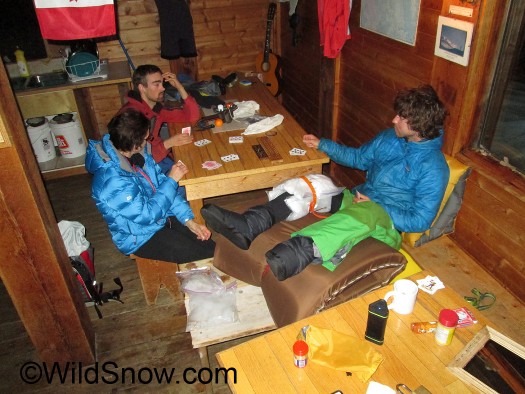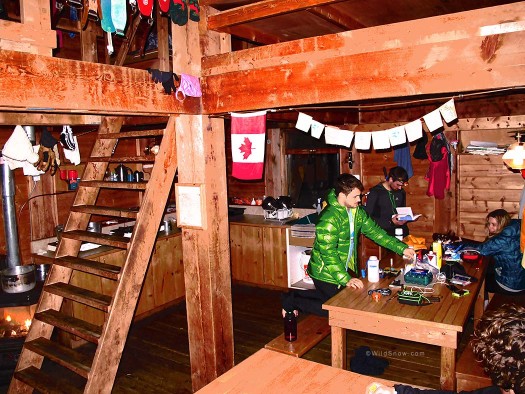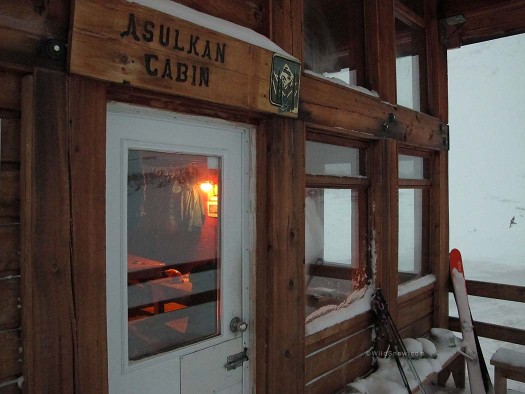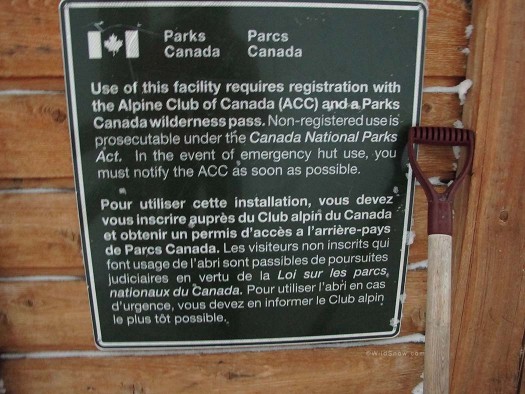Four days in the legendary Asulkan Cabin. It’s rustic, but to a ski mountaineer this is the Queen Mary, only with skiing. Asulkan is a simple cabin in a sublime location. Understated, nothing pretentious. Quite a contrast to some of the luxury diggs we’ve experienced in Europe. Having been to hundreds of “huts,” here is my take on Asulkan through the lens of planning our own mountain hut construction (one of my dreams).
Overall: As with many of the higher huts in Europe, Asulkan is provisioned by helicopter. This is obvious in how spartan everything is. More, it’s evident the place is well used if not over-used, making upkeep challenging. I like the “humanized” feel of a shelter that gets traffic, but it’s obvious Asulkan is a lot of work for the folks on maintenance. One has to admire how we’ll they’re doing.

Conventional steel residential door greets you. Nothing pretentious other than the deserving mountains rising above.
Energy: Cooking and lighting are supplied via propane gas. I’ve always felt this was a terrific way to avoid the tyranny of cellulose fuel. The crackling wood stove can be a beautiful thing, but gathering and splitting firewood are not essential to backcountry skiing. The problem with gas is it can get dangerous. Asulkan has the essential timer valve on the heater, but the cooktop and gas lighting are not on timers. It’s not a particularly airtight cabin so perhaps accidental gas isn’t a problem. But I was surprised the place had neither a carbon monoxide detector nor a gas detector.
Size: 12 people is the maximum by reservation, and would be a bit “friendly.” The approximately 16 x 20 foot floor plan (321 square feet) is not exactly the great room of a 10th Mountain Hut in Colorado, or a gigantic gasthaus in Austria, but it has a good feel. Upstairs is all bunks, most of the continuous variety found in “lagers” worldwide. Bring earplugs and don’t kick in our sleep or you’ll make enemies. Me, my problem is I’m a talking and shouting sleeper (gets rather embarrassing in the bunk room, especially when I start shouting random female names), perhaps I need a muzzle along with the ear plugs.
Construction: Asulkan’s post-and-beam construction is probably a good solution for a solid structure that can be kitted out for heli transport. Problem with post-beam is how you fill in the rectangular bays formed by the superstructure. You can do a nice job with the carpentry, then as the structure expands and contracts is seems to always leave gaps that may cause rather robust air movement. Only solution I’ve found is lots of work caulking, and re-caulking with best quality flexible caulk. Doing so is a huge amount of tedious work, and expensive. I can just imagine the battle they’ve been fighting to keep those cracks closed up.
Sanitation: Outhouse works on the barrel system. Wherein a large container rests under the toilet seat. When filled, the container is moved outside, capped, and replaced with an empty. All flown out by heli. This basic system is used for quite a few huts worldwide, but nowadays you have to wonder if we could _finally_ get a composting toilet to work in this sort of situation. Indeed, I’m thinking we need to experiment with this at Wildsnow Field HQ, where we now use a variation of the barrel system. We were surprised to find no designated “pee hole” or tube near the building, instead the hut was surrounded by frozen plots of the proverbial yellow left by previous visitors. Again, something we could do better with ourselves at HQ, so now I’m inspired to work harder on a viable system.
Dry cabin living: The usual sink that drains to buckets. When filled you drain the buckets into a dry well a few feet outside the door. We learned a cool trick from how Asulkan has this set up. Probably familiar to you guys who do the dry cabin thing, but new to us: Set a strainer on the bucket so dish water gets the solids taken out, to be burned, scattered, or hauled out (depending on each hut’s situation). All water at Asulkan is obtained by melting snow, large pots on top of the propane heater do a fine job of this (a process we’re used to from many of the Colorado huts).
That’s about it. Asulkan. What a special place. Can’t wait to return and hopefully get to the alpine we had to miss. Good job Canadians!
(Note, I’m thinking of starting a new category, Mountain Huts. We’ll review the huts we visit, from the point of view as a builder as well as a guest. Should be fun.)
WildSnow.com publisher emeritus and founder Lou (Louis Dawson) has a 50+ years career in climbing, backcountry skiing and ski mountaineering. He was the first person in history to ski down all 54 Colorado 14,000-foot peaks, has authored numerous books about about backcountry skiing, and has skied from the summit of Denali in Alaska, North America’s highest mountain.









